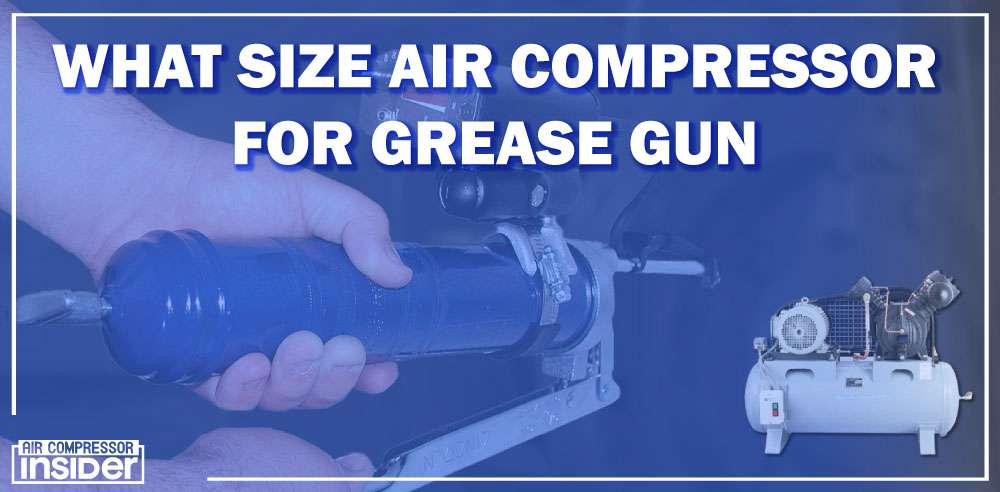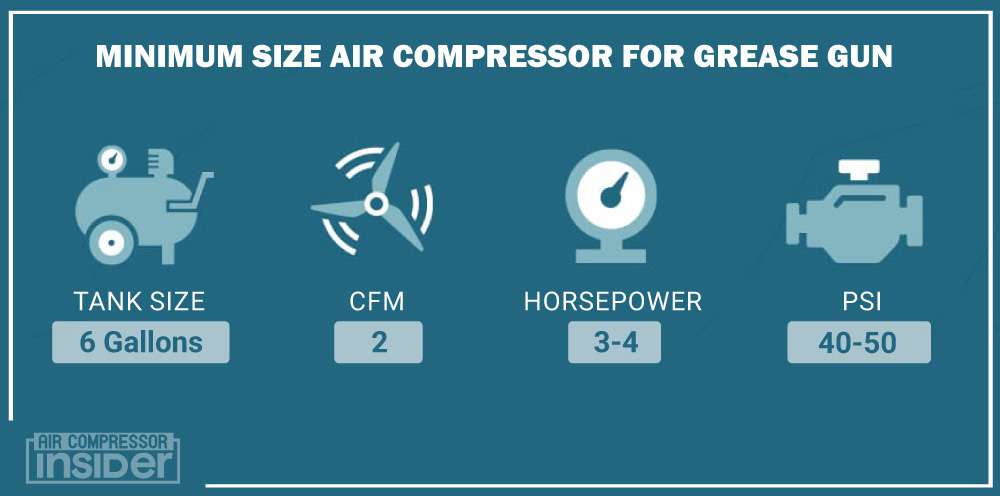Are you a grease gun user wondering what size air compressor to use for your job? If so, this guide is written for you! In it, we will detail everything you need to know about finding the perfect air compressor size for your needs. That’s why we have created this comprehensive guide. We examine what type of air compressor is most efficient and effective, as well as listing out all available sizes so that you can make an informed decision on which one will work best for you.
We will also explain how various measurements like CFM, SCFM, PSI and tank volume factor into the decision making process so you can make perfect choice when selecting an air compressor for grease gun. Read on and learn how to select the perfect size of air compressor for your grease gun.
What Size Air Compressor For Grease Gun

For grease guns, you’ll need an air compressor with a CFM rating of at least 2 and a PSI rating between 40-50. HP should be in the 3-4 range, and the tank size should be around 6 gallons or higher.

What Is A Grease Gun?
A grease gun is a device used to dispense lubricating oil or grease in controlled amounts. It works by pushing the lubricant through a tube, nozzle and then onto the surface that needs lubrication. Grease guns are commonly found in industrial, commercial and automotive applications and can be hand operated, air operated or electric powered. Hand operated grease guns typically use a ratchet-driven plunger, while air- and electric-powered models use pressure to force the lubricant out of the nozzle.
Types of Grease Guns:
There are a few different types of grease gun available. Each type of grease gun has its own advantages and drawbacks, ranging from convenience to cost-effectiveness.
1- Hand Operated Grease Guns
2- Electric Gowered Grease Guns
3- Air Powered Grease Guns
4- Battery Operated Grease Guns
1- Hand Operated Grease Guns:
Hand-operated grease guns are the most common and affordable type of grease gun. They are manually operated by turning a handle or ratchet that pushes the lubricant out of the nozzle. This type of grease gun is convenient for occasional use and does not require an external power source.
2- Electric Powered Grease Guns:
Electric powered grease guns are more powerful than hand operated models and require an external power source. They are ideal for heavy-duty jobs that need a lot of lubricant over short periods of time, as they provide greater pressure than hand operated grease guns.
3- Air Powered Grease Guns:
Air powered grease guns are among the most powerful types of greasing tools available. An air compressor is used to generate sufficient pressure to move the lubricant through the nozzle and onto the surface needing lubrication. This type of grease gun can be used for larger tasks or in areas with limited access which may not be suitable for electric versions.
4- Battery Operated Grease Guns:
Battery operated grease guns are becoming increasingly popular due to their convenience and portability. These models are powered by a rechargeable battery and are ideal for tasks that require frequent use.
7 Important Factors to Consider When Selecting an Air Compressor for Grease Gun:

When choosing an air compressor for your grease gun, there are a few important factors to consider. Some of the most important aspects include the PSI (pound-force per square inch), HP (horsepower), tank size, CFM (cubic feet per minute), flow meter and duty cycle.
1. PSI Rate:
The most important factor when selecting an air compressor is its PSI rating, which is a measure of how much pressure the compressor can deliver. The higher the rating, the more powerful it will be and thus capable of delivering more lubricant faster.
2. Horsepower:
Horsepower (HP) is another key factor that should not be overlooked when purchasing an air compressor. It determines how quickly an air compressor can refill its tank and how powerful it is.
3. Tank Size:
The size of the air compressor’s tank will also affect its performance, as it determines how much lubricant can be delivered at any one time. A larger tank will provide more consistent lubrication than a smaller tank, which may need to be refilled more often.
4. CFM Air Output:
CFM (cubic feet per minute) measures the rate at which an air compressor can deliver a certain volume of air or gas. It should match the specific requirements of your grease gun in order to provide optimal performance.
5. Flow Meter:
Flow meters measure the amount of lubricant that passes through the nozzle over time, allowing you to adjust flow rates for greater accuracy.
6. Duty Cycle:
Duty cycle is the ratio of time that an air compressor can operate before needing to rest. A higher duty cycle rating will enable your grease gun to run for longer periods without needing to take a break.
7. Portability:
Depending on your needs, you may want to consider an air compressor which is easy to transport from one site to another. Portable models are often more expensive than their stationary counterparts but can be essential for those who need greater flexibility in how and where they use their grease guns.
Factors in Detail:
Now let’s discuss these 7 factors one by one in detail.
PSI Requirement for Grease Gun:
The first factor to consider when selecting an air compressor is the PSI rating. Most grease guns require a minimum of 40-50 PSI with a maximum of 100 PSI. If your grease gun requires more than 100 PSI, you will need to select an air compressor which can accommodate this requirement.
CFM Requirement for Grease Gun:
The CFM rating is another important factor when selecting an air compressor for your grease gun. This rating measures how much volume of air or gas an air compressor can deliver over a certain amount of time. If your grease gun requires more than the standard CFM rating, then you will need to select an air compressor which has a higher rating to ensure optimal performance.
Horsepower Requirement for Grease Gun:
The second factor to consider is the HP rating. Most grease guns require an air compressor which has a minimum of 1 HP and a maximum of 3-4 HP for optimal performance.
Tank Size Requirement for Grease Gun:
The size of the tank on your air compressor will also affect its performance. Generally speaking, the larger the tank size, the more consistent the delivery of lubricant will be. However, a smaller tank may need to be refilled more often.
Flow Meter Requirement for Grease Gun:
A flow meter is another important feature when selecting an air compressor. This device measures the amount of lubricant that passes through the nozzle and allows you to adjust flow rates for greater accuracy.
Duty Cycle Requirement for Grease Gun:
Finally, you should also consider the duty cycle rating when buying an air compressor for your grease gun. This measures how long it can run before needing to rest and should match the specific requirements of your grease gun.
Portability Requirement for Grease Gun:
In addition, you should take into account the portability of your air compressor. Depending on your needs, you may want to consider a portable model which is easy to transport from one site to another. Portable models are often more expensive than their stationary counterparts but can be essential for those who need greater flexibility in how and where they use their grease guns.
Frequently Asked Questions
Question #1
What is the minimum PSI required to run a grease gun with an air compressor?
Most grease guns require a minimum of 40-50 PSI with a maximum of 100 PSI.
Question #2
What is the minimum HP required to run a grease gun with an air compressor?
Most grease guns require an air compressor which has a minimum of 1 HP and a maximum of 3-4 HP for optimal performance.
Question #3
How does tank size affect running a grease gun with an air compressor?
Generally speaking, the larger the tank size, the more consistent the delivery of lubricant will be. However, a smaller tank may need to be refilled more often.
Question #4
What is the importance of CFM when running a grease gun with an air compressor?
The CFM rating measures how much volume of air or gas an air compressor can deliver over a certain amount of time. If your grease gun requires more than the standard CFM rating, then you will need to select an air compressor which has a higher rating to ensure optimal performance.
Question #5
Is it important to have a flow meter when using an air compressor with a grease gun?
Yes, having a flow meter is important as it measures the amount of lubricant that passes through the nozzle and allows you to adjust flow rates for greater accuracy.
Question #6
What is the importance of duty cycle when running a grease gun with an air compressor?
The duty cycle rating measures how long it can run before needing to rest and should match the specific requirements of your grease gun.
Question #7
Is portability important when selecting an air compressor for use with a grease gun?
Depending on your needs, you may want to consider a portable model which is easy to transport from one site to another. Portable models are often more expensive than their stationary counterparts but can be essential for those who need greater flexibility in how and where they use their grease guns.
Question #8
Are there any other factors I should consider when buying an air compressor for my grease gun?
Yes, it is also important to take into account the noise level of your air compressor, as well as the cost of operation.
Question #9
What type of lubricant is best used with a grease gun and air compressor?
Most grease guns are compatible with standard lithium-based lubricants.
Question #10
Are there any safety considerations when using an air compressor for a grease gun?
Yes, it is important to follow all safety guidelines when using an air compressor with a grease gun, including wearing appropriate protective gear such as goggles and gloves. Additionally, always be sure to double check that all connections are secure before each use
Conclusion:
In conclusion, selecting the right size air compressor for your needs is an important part of ensuring optimal performance from your grease gun. By considering factors such as PSI, HP, tank size, CFM rating, flow meter, duty cycle and portability you can ensure that you select the perfect air compressor to suit your needs. Additionally, it is important to keep in mind safety considerations when using an air compressor with a grease gun.
